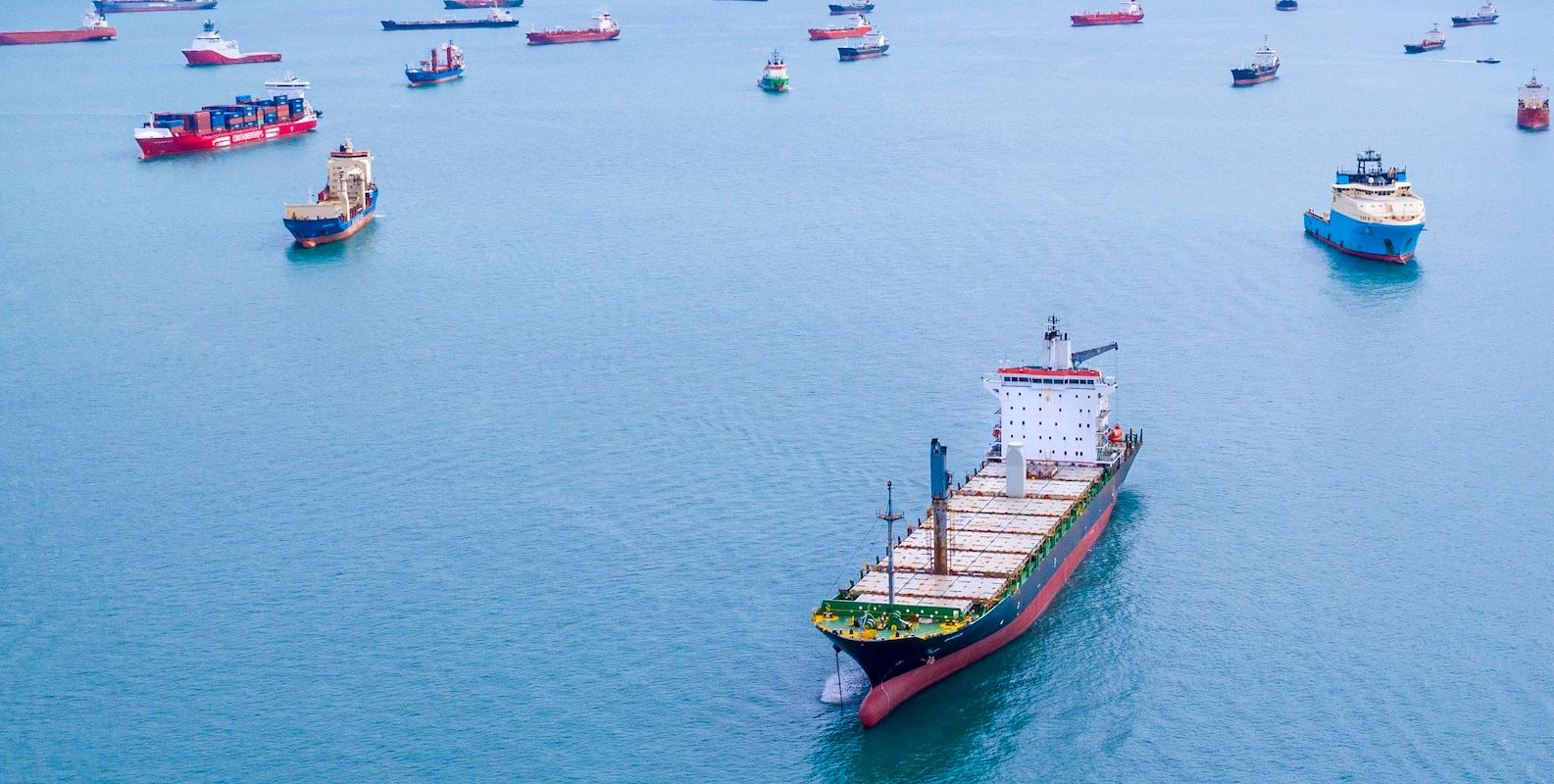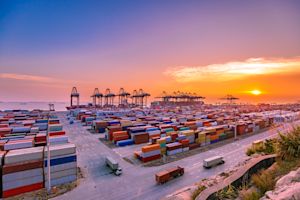
Global Logistics Update
New Executive Order Reduces Cumulative Tariff Costs; China to US Blank Sailings Persist
North America vessel dwell times and other updates from the global supply chain | May 17, 2023
Global Logistics Update: May 1, 2025

Trends to Watch
Talking Tariffs:
We launched the Flexport Tariff Simulator. Estimate and forecast tariffs and landed costs for each shipment, all based on real-time data and the latest rates and regulations.
U.S. Customs and Border Protection (CBP) Provides Critical Clarification Regarding Section 232 Tariffs: On April 28, CBP clarified that steel and aluminum derivative products subject to Section 232 tariffs are completely excluded from IEEPA reciprocal tariffs. To qualify, the product must fall under an HTSUS item listed in the Section 232 tariff steel and/or aluminum orders, and contain any percentage of steel or aluminum content subject to one or both of the orders. Prior to CBP’s notice, it was unclear whether reciprocal tariffs would apply to the non-steel or non-aluminum content of derivative steel and aluminum products.
- Additionally, on April 30, Flexport received confirmation from CBP’s Trade Remedy Branch that products scoped under Section 232 for steel or aluminum derivatives but do not actually contain any steel or aluminum are subject to reciprocal tariffs.
CBP Clarifies the ‘In-Transit Exemption’ for IEEPA Reciprocal Tariffs Is Limited to Sea Freight Vessels: On April 30, CBP clarified that the reciprocal in-transit exemption applies only to ships—not air, rail, truck, or any other mode of transport. Goods moving via another mode after April 5 will be subject to reciprocal tariffs. Additionally, shipments beginning by vessel and arriving in the United States via a different mode of transportation, often referred to as transloading, are not covered by this exemption.
Trump Administration Clarifies Rules for Calculating Duties on Products Covered by Overlapping Tariff Measures: On April 29, President Trump signed an executive order addressing the stacking effect of certain tariff measures, which the order states resulted in duty rates that exceeded the amount necessary to achieve the president’s policy goals. To reduce the cumulative effect of overlapping tariffs on certain items, the order sets out procedures for determining which tariff measures apply, as follows:
- Automobiles and auto parts subject to 25% tariffs under Proclamation 10908 will not be subject to Section 232 tariffs on steel and aluminum products and derivative products, nor to 25% IEEPA “fentanyl” tariffs applicable to products from Canada and Mexico.
- Goods from Canada or Mexico that are non-originating under USMCA rules of origin and subject to IEEPA fentanyl tariffs will not be subject to Section 232 tariffs on steel and aluminum products and derivative products.
- Steel and aluminum products and derivative products that contain both steel and aluminum will be subject to the tariff measures set out in both the Section 232 steel order and the Section 232 aluminum order, to the extent that each order is applicable to the product. The non-metal content of derivative products is still excluded from these tariffs.
The above rules apply retroactively to entries filed on or after March 4, 2025. Normal Trade Relations rates of duty; IEEPA fentanyl tariffs applicable to goods of China; IEEPA reciprocal tariffs; Section 301 tariffs; and antidumping or countervailing duties continue to apply in addition to the tariffs outlined above.
Given the above clarifications, importers may request refunds for any duty overpayments via CBP post entry correction procedures. Flexport customers may contact postentry@flexport.com for assistance with refund requests. See our live blog post for more details.
Ocean: Trans-Pacific Eastbound (TPEB)
- Capacity and Demand: In Week 18, offered capacity was 17% below standard levels for TPEB. This is driven by significant declines in both demand and subsequent blank sailings from China to the U.S. Compared to last week, however, demand from China has not declined further. There have not yet been any notable demand increases from the rest of Southeast Asia.
- Blank Sailings, Primarily from China to the U.S.: Carriers have significantly reduced capacity for May. Right now, 29% of sailings have been canceled for the week of May 5, limiting capacity from China to the U.S. to roughly 70%. Carriers are canceling sailings due to a steep decrease in demand: our signals show that demand since Liberation Day (April 2) is approximately 49% lower than the previous 4-week average. We also anticipate that some decline is also due to the Chinese Labor Day holiday week.

There are 10 service loops that have been suspended either temporarily or indefinitely. Ocean Alliance (CMA CGM, COSCO, Evergreen, and Orient Overseas Container Liner), Premier Alliance (ONE, HMM, YML), and ZIM/MSC have completely suspended 10 of their weekly service loops. See Table 1 below for updated suspensions, and check out our blog post for more details.
Table 1: Suspended Transpacific Eastbound Service Loops
| Carrier / Alliance | Service Loop | Suspension Period |
|---|---|---|
| Ocean Alliance | PRX / CP1 / PCS1 / PRX / AAS2 | Week 17 - 26 |
| Ocean Alliance | SEA3 / PSX | Week 18 - 23 |
| Ocean Alliance | CPS / AAC2 / HBB / PCN3 | Week 17 - 21 |
| Ocean Alliance | CBX / ECC3 / AWE7 / CBX | Week 16 - 24 |
| Mediterranean Shipping Company | ORIENT | Week 16 until further notice |
| ZIM | ZX2 | Week 16 until further notice |
| Premier Alliance | PN4 | Scheduled to begin in May, suspended until further notice |
| Premier Alliance | PS5 | Scheduled to begin in May, suspended until further notice |
| Mediterranean Shipping Company / ZIM | PELICAN / ZSL | Week 19 until further notice |
| Mediterranean Shipping Company / ZIM | EMPIRE / ZNS | Week 20 until further notice |
- Equipment: Currently, the overall availability of equipment (like containers) is sufficient. There are no significant concerns about shortages at this time.
- Freight Rates: Most carriers have announced General Rate Increases (GRIs), effective May 1. These GRIs are likely an attempt to balance reduced supply (due to blank sailings) and demand.
Ocean: Far East Westbound (FEWB)
- Capacity and Demand:
- Asia factory exports have improved slightly and a modest rebound is expected in early May, mainly due to seasonal restocking in the summer.
- European demand remains subdued, with no signs of a rebound yet. Due to macroeconomic uncertainty, continued inflationary pressures, and reduced consumer spending, demand will not see a significant increase.
- Capacity oversupply on the Europe route remains. Carriers are proactively managing space via blank sailings: April’s blank sailing ratio held at 5-8%, while forecasts for May’s blank sailing ratio project 8-10%.
- Equipment availability is improving overall, but remains tight for several carriers at major Chinese ports.
- Freight Rates:
- The Shanghai Containerized Freight Index (SCFI) has remained stable for seven consecutive weeks, but on a slow decline, dipping -2% WoW in mid-April. This trend is expected to continue until mid-May.
- Despite weak demand, freight rates are unlikely to drop further and will stabilize in the short term.
Ocean: Trans-Atlantic Westbound (TAWB)
- Capacity and Demand: Congestion persists at the Ports of Piraeus, Genoa, and Valencia in the Mediterranean, and in Hamburg, Antwerp, Rotterdam, and Le Havre in North Europe. This has resulted in delays, impacting schedule reliability. Blank sailing numbers have decreased.
- Equipment: Equipment shortages persist in parts of Central Europe, particularly in Austria, Slovakia, Switzerland, Hungary, and Southern/Eastern Germany. Carrier haulage is recommended for these origins. No major issues in other ports and regions.
- Freight Rates: Due to the postponement of U.S. tariffs in the EU, carriers are anticipating a peak in demand for the next 90 days. Some carriers have already implemented a Peak Season Surcharge (PSS) ex North Europe beginning May 13.
- West Mediterranean: the PSS that was planned for April will be applied at the beginning of May. Meanwhile, some carriers have postponed the PSS to the second week of May.
- East Mediterranean: carriers are implementing PSSs and GRIs at the beginning of May, as they anticipate demand to increase from Turkey, Greece, and Egypt.
Air Freight Update (Week 16: April 14 - April 20, 2025):
- Global Tonnages Down -6% WoW; Rates Fell -2% WoW: Asia-Pacific demand and pricing weakened due to the effects of the Easter holiday and U.S. tariff uncertainty. Unlike last year, rates declined instead of rising.
- Asia-Pacific to U.S. Traffic Dropped -7% WoW, with Rates Down -8% WoW: China and Hong Kong volumes fell for the fourth straight week; strong Vietnam (+42% YoY), Taiwan (+30%), Thailand (+24%), and Japan (+12%) exports cushioned the overall Asia-Pacific decline.
- Asia-Pacific to Europe Market Increasingly Stable: Tonnages dipped -4% WoW after seven weeks of growth post-Lunar New Year. Spot rates hovered around $4/kg, with China-Europe rates stable at $4.23/kg in Week 16.
- Capacity Still +3% YoY, but Eased -1.2% WoW: Global air cargo capacity remains above last year’s levels. Expect volatility ahead in light of U.S. de minimis rule changes, which may possibly shift freighter deployments.
Source: worldacd.com
Please reach out to your account representative for details on any impacts to your shipments.
North America Vessel Dwell Times

Webinars
The Control Tower Advantage: Visibility, Agility, and Smarter Decisions
Available on Demand
Ocean Timeliness Indicator
This week, the Flexport OTI for China to the U.S. West Coast remained stable for yet another week, while China to the U.S. East Coast showed a small uptick. Meanwhile, China to North Europe appears to be falling considerably week after week.
Week to April 28, 2025
This week, the Ocean Timeliness Indicator (OTI) for China to the U.S. West Coast remained idle at 33 days, while China to the U.S. East Coast showcased a small uptick, increasing from 48 to 50 days. Meanwhile, China to North Europe appeared to be in free fall, dropping from 69.5 to 61 days.

About the Author






